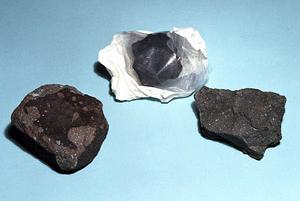|
Ornans (meteorite)
The Ornans meteorite is a carbonaceous chondrite and the type specimen of the CO group (Carbonaceous Ornans group). Its fall was observed in France France (), officially the French Republic ( ), is a country primarily located in Western Europe. It also comprises of Overseas France, overseas regions and territories in the Americas and the Atlantic Ocean, Atlantic, Pacific Ocean, Pac ... in 1868. References Meteorites found in France {{Meteorite-stub ... [...More Info...] [...Related Items...] OR: [Wikipedia] [Google] [Baidu] |
Chondrite
A chondrite is a stony (non-metallic) meteorite that has not been modified, by either melting or differentiation of the parent body. They are formed when various types of dust and small grains in the early Solar System accreted to form primitive asteroids. Some such bodies that are captured in the planet's gravity well become the most common type of meteorite by (whether quickly, or after many orbits) arriving on a trajectory toward the planet's surface. Estimates for their contribution to the total meteorite population vary between 85.7% and 86.2%. Their study provides important clues for understanding the origin and age of the Solar System, the synthesis of organic compounds, the origin of life and the presence of water on Earth. One of their characteristics is the presence of chondrules (from the Ancient Greek χόνδρος ''chondros'', grain), which are round grains formed as molten, or partially molten droplets, in the space by distinct minerals, that normally consti ... [...More Info...] [...Related Items...] OR: [Wikipedia] [Google] [Baidu] |
Carbonaceous Chondrite
Carbonaceous chondrites or C chondrites are a class of chondritic meteorites comprising at least 8 known groups and many ungrouped meteorites. They include some of the most primitive known meteorites. The C chondrites represent only a small proportion (4.6%) of meteorite falls. Some famous carbonaceous chondrites are: Allende, Murchison, Orgueil, Ivuna, Murray, Tagish Lake, Sutter's Mill and Winchcombe. General description C chondrites contain a high proportion of carbon (up to 3%), which is in the form of graphite, carbonates and organic compounds, including amino acids. In addition, they contain water and minerals that have been modified by the influence of water. The carbonaceous chondrites were not exposed to higher temperatures, so that they are hardly changed by thermal processes. Some carbonaceous chondrites, such as the Allende meteorite, contain calcium-aluminum-rich inclusions (CAIs). These are compounds that emerged early from the primeval solar nebula, cond ... [...More Info...] [...Related Items...] OR: [Wikipedia] [Google] [Baidu] |
France
France (), officially the French Republic ( ), is a country primarily located in Western Europe. It also comprises of Overseas France, overseas regions and territories in the Americas and the Atlantic Ocean, Atlantic, Pacific Ocean, Pacific and Indian Oceans. Its Metropolitan France, metropolitan area extends from the Rhine to the Atlantic Ocean and from the Mediterranean Sea to the English Channel and the North Sea; overseas territories include French Guiana in South America, Saint Pierre and Miquelon in the North Atlantic, the French West Indies, and many islands in Oceania and the Indian Ocean. Due to its several coastal territories, France has the largest exclusive economic zone in the world. France borders Belgium, Luxembourg, Germany, Switzerland, Monaco, Italy, Andorra, and Spain in continental Europe, as well as the Kingdom of the Netherlands, Netherlands, Suriname, and Brazil in the Americas via its overseas territories in French Guiana and Saint Martin (island), ... [...More Info...] [...Related Items...] OR: [Wikipedia] [Google] [Baidu] |
Carbonaceous Chondrite
Carbonaceous chondrites or C chondrites are a class of chondritic meteorites comprising at least 8 known groups and many ungrouped meteorites. They include some of the most primitive known meteorites. The C chondrites represent only a small proportion (4.6%) of meteorite falls. Some famous carbonaceous chondrites are: Allende, Murchison, Orgueil, Ivuna, Murray, Tagish Lake, Sutter's Mill and Winchcombe. General description C chondrites contain a high proportion of carbon (up to 3%), which is in the form of graphite, carbonates and organic compounds, including amino acids. In addition, they contain water and minerals that have been modified by the influence of water. The carbonaceous chondrites were not exposed to higher temperatures, so that they are hardly changed by thermal processes. Some carbonaceous chondrites, such as the Allende meteorite, contain calcium-aluminum-rich inclusions (CAIs). These are compounds that emerged early from the primeval solar nebula, cond ... [...More Info...] [...Related Items...] OR: [Wikipedia] [Google] [Baidu] |


